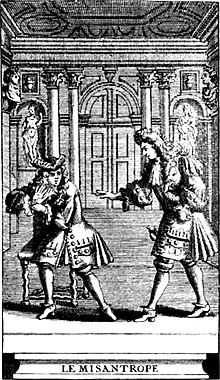| The Misanthrope | |
|---|---|
 Engraving from the 1719 edition | |
| Written by | Molière |
| Date premiered | 4 June 1666 |
| Place premiered | Théâtre du Palais-Royal, Paris |
| Original language | French |
| Subject | Behavior of the aristocracy. |
| Genre | Comedy of manners |
| Setting | Grand Siècle, France |
The Misanthrope, or the Cantankerous Lover (French: Le Misanthrope ou l'Atrabilaire amoureux; French pronunciation: [lə mizɑ̃tʁɔp u latʁabilɛːʁ amuʁø]) is a 17th-century comedy of manners in verse written by Molière. It was first performed on 4 June 1666 at the Théâtre du Palais-Royal, Paris by the King's Players.[1]
The play satirizes the hypocrisies of French aristocratic society, but it also engages a more serious tone when pointing out the flaws that afflict all humans. The play differs from other farces of the time by employing dynamic characters like Alceste and Célimène as opposed to the flat caricatures of traditional social satire. It also differs from most of Molière's other works by focusing more on character development and nuances than on plot progression. The play, though not a commercial success in its time, survives as Molière's best-known work today.
Because both Tartuffe and Don Juan, two of Molière's previous plays, had already been banned by the French government, Molière may have softened his ideas to make the play more socially acceptable. As a result, there is much ambiguity about whether the main character Alceste is intended as a hero for his uncompromising honesty, or as a quixotic fool. Molière has been the target of much criticism for The Misanthrope over the years. The French philosopher Jean-Jacques Rousseau claimed in his Letter to M. D'Alembert on Spectacles that it was Molière's best work, but hated that it made Alceste the butt of its humor. He believed the audience should support Alceste's high ideals rather than laugh at his misadventures.
- ^ Molière (23 June 1968). The Misanthrope, and Other Plays. New American Library. Retrieved 23 June 2018 – via Internet Archive.